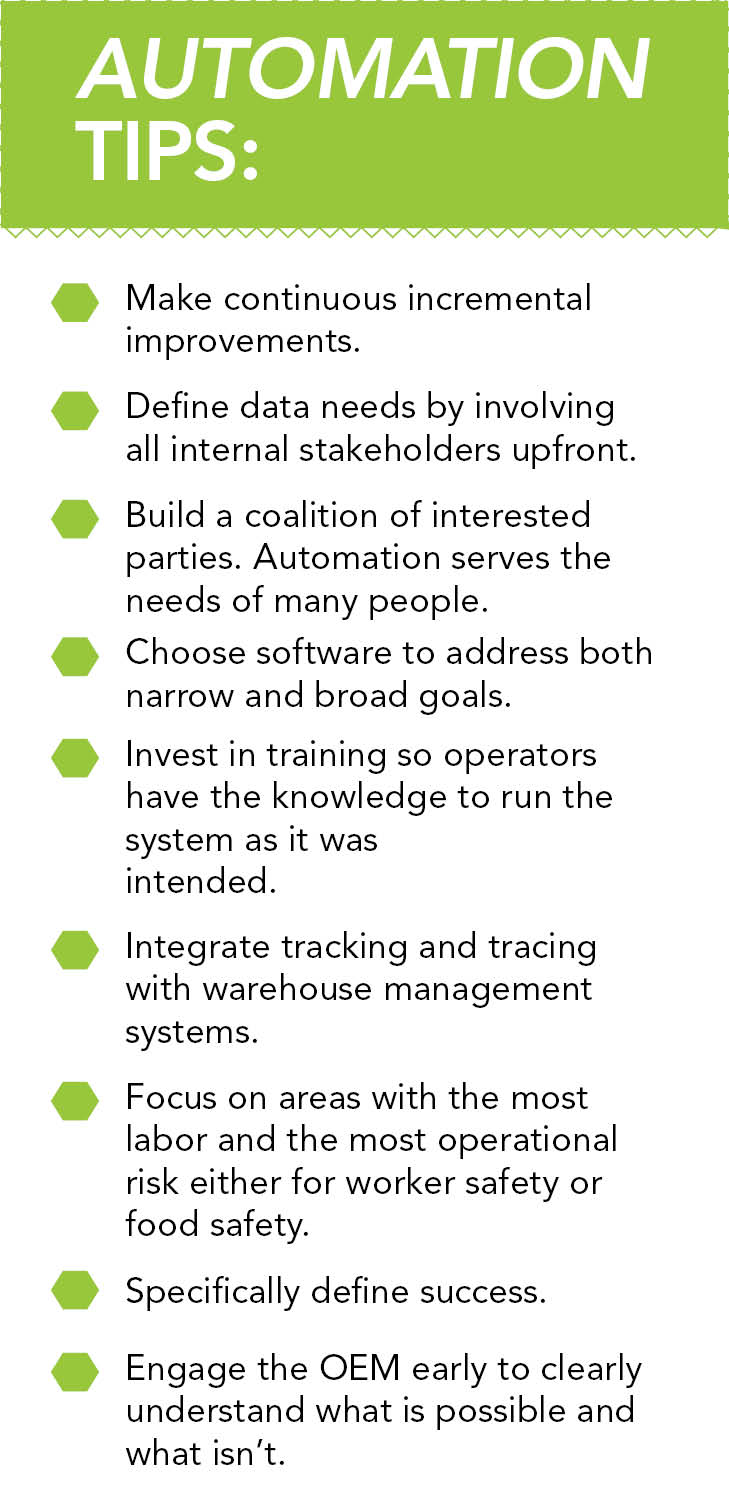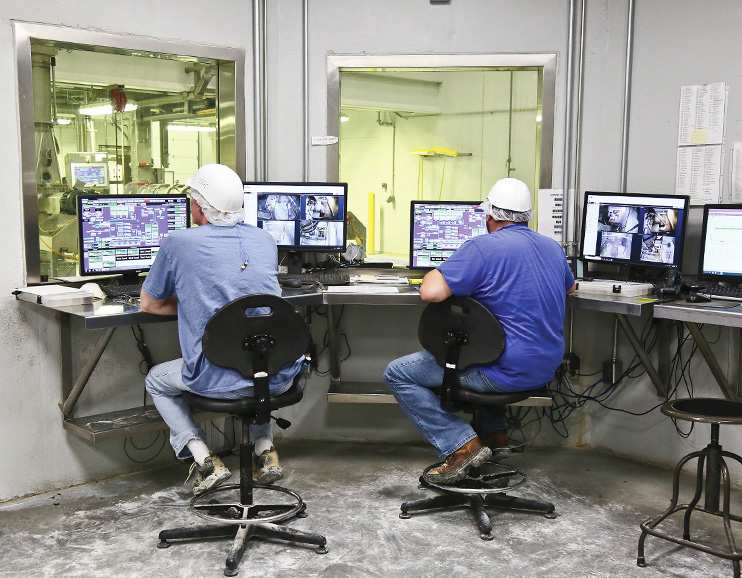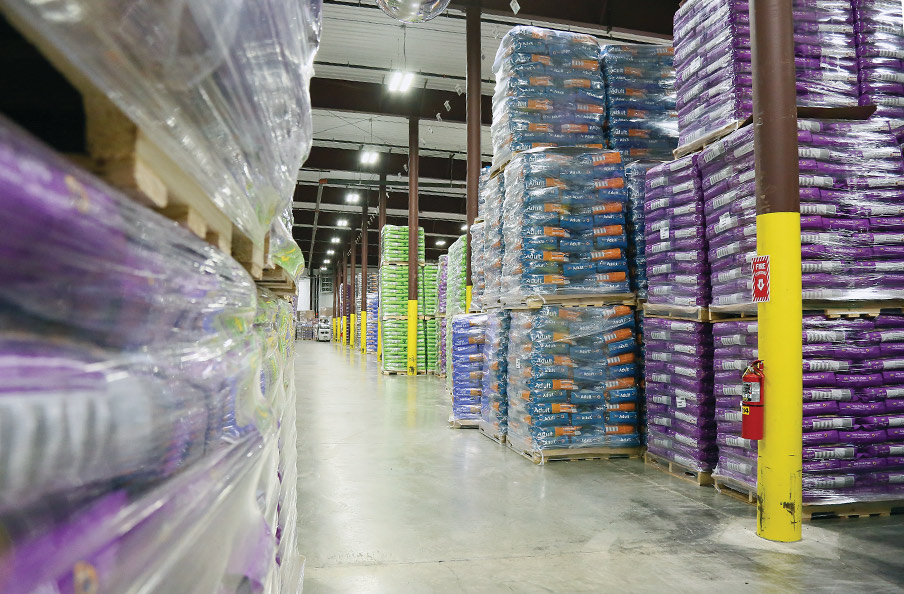This article was published in the September 2020 issue of Pet Food Processing. Read it and other articles from this issue in our September digital edition.
The potential benefits of combining automated processing systems, where decisions are driven by up-to-date data and a technology-enabled workforce across an entire organization, are vast. Prioritizing where to start, optimizing what is already in-house and truly implementing automation throughout a processing company are key.
Roger Woehl, chief technical officer at SafetyChain, Novato, Calif., said there are two perspectives on where automation offers the greatest benefits.
“The first and most obvious is the bottom-line savings from increasing productivity,” Woehl said. “The second, and maybe less clear, is the value of protecting brands and reputations from recalls or quality issues. These issues, although less common, can be far more damaging to business value. Wholistic systems that drive automation across operations, safety and quality drive a single approach for maximizing immediate ROI while protecting long-term brand quality and reputation.”
As the production of food and treats for cats and dogs more closely matches the product formats and processes seen in human food productions, managing quality becomes more complex.
“The standard for pet food is rising dramatically,” said Aaron Kaiser, supplier quality engineer, Freshpet, Secaucus, N.J. “…An important factor in ensuring that level of quality is being able to monitor key quality parameters of raw materials and finished product and getting that data to the decision-makers in real-time. This promotes a proactive approach to assuring quality rather than one that is more often reactive and control based. This approach most importantly assures the production of safe, consistent, high-quality food for our pets, but also reduces waste and increases efficiency.”
 The potential is exciting but the reality of how to realize the full benefits is complex. Selecting what to automate and how to fully utilize available technology to positively impact the overall business can be a challenge.
The potential is exciting but the reality of how to realize the full benefits is complex. Selecting what to automate and how to fully utilize available technology to positively impact the overall business can be a challenge.
Already in-house
Pete Ensch, chief executive officer, WEM Automation, New Berlin, Wis., said the low hanging fruit in a processing environment is to fully utilize the automation that is already in-house.
“So many times, you see pet food producers not using the automation they have,” Ensch said. “Often because they have an operator that believes they can run better without it or there was an electrical or mechanical failure that required a short-term bypass that became a long-term fix. Go back, review what you have, fire it back up, use continuous improvement techniques to prove the automation works – it will justify doing more.
“[Processors] often have a number of automation and control suppliers used throughout the plant in different areas but not much integrated,” he added. “Pulling data from all of the areas can be a real challenge. Working with an automation supplier that also does SCADA [supervisory control and data acquisition] or MES [manufacturing execution systems] can be a real advantage because these systems can pull all the information into a central location so you can more easily and effectively use the data.”
Conquering complexity
The continued expansion of pet food product lines has driven much of the automation investment over the past couple of years. The number of ingredients and the variety of flow rates of those materials have increased the number of bins from which raw materials are pulled to produce the variety consumers want.
“The expanded equipment involved, as well as complexity, is perfect for automation,” Ensch said. “Automation can deal with this complexity well and reduce the number of operator errors.”
Packaging is another area that has become more complex in recent years.
“Pet food producers and especially the treat processors have so many package types and sizes to deal with and this has not only expanded the number of packaging lines but the need to do frequent changeovers,” Ensch added.
Taking automated packaging systems one step further by automating secondary — end of line — packaging to make it retail ready serves to support and streamline the retail aisle and help brands differentiate themselves on the shelf.

“Some believe hand-packing [packaged products] is most flexible but that comes at a cost,” said Peter Fox, senior vice president of sales, SOMIC America, Eagan, Minn. “Hand packing is slower, the cost of packaging materials for hand pack can be 15% to 20% more than materials that run in form-fill machines, plus automation offers shelf-ready, display-ready packaging formats that can’t be done by hand. Growth in e-commerce is increasing demand for smaller volume packages, which requires faster machines to maintain or increase capacity.”
Packaging’s influence on automation is also a factor in wet pet food and treat processing applications. The cost savings driving investments in automation in canneries are not only labor savings and production efficiencies, but packaging materials as well.
“Automated systems are more efficient at running less expensive, thinner cans with different style openings or different coatings than manual processes allow with these types of materials,” said Eric Hanrahan, general manager, Allpax, Covington, La.
“Also, with the increased popularity of wet pet foods, the demand for flexibles — trays and cups — justifies the need to add capability for different containers,” he added. “This adds complexity that automation is designed to handle efficiently.”
Safeguarding resources
In many processing environments including pet food canning facilities, energy usage can be one of the larger costs after labor. Hanrahan said automation and intelligent technology can play an increasing role in energy recovery, reuse and reduction.
For dry pet food and treats, the dryer is typically the most expensive piece of equipment to run in the plant due to energy consumption, explained Brad Stokke, principal engineer, WEM Automation, New Berlin, Wis.
“Automated monitoring of inlet and outlet moistures at the dryer, with the ability to make changes of dryer zone temperatures, bed speeds, or both to achieve optimal discharge moistures, can have great return on investment,” Stokke said. “Not only is it tied directly to product quality, additional process controls can greatly reduce energy cost.”
Technology can allow processors to catch the data that identifies trends and allows them to improve their process. It also is key to optimizing and safeguarding limited resources. An example is optical sorting technology that identifies and expels foreign material in pet food product.

“Almost no product gets diverted when the foreign material is removed,” said Lars Povlsen, global sales manager proteins, TOMRA Food. “This preserves the resources used to create the product and also dramatically reduces waste. Today’s technology enables a smoother production flow from one recipe to another and safeguards against cross-contamination.”
Technology can do what humans simply can’t by providing as much control as possible to preserve the investment in production and preserve the brand and the resiliency of the company as well.
Stokke emphasized that tying all of the processes of a plant together — from raw material coming in to finished product going out and all the interlinked data in between — is becoming more important in managing the complexity of a modern plant.
Data at work
Capturing data along the production route from the moment processes start offers benefits when accessible.
“Any step that increases batch production speed while automating tasks will minimize labor and increase plant output,” said Joe Lewis, marketing associate, Sterling Systems & Controls, Inc., Sterling, Ill. “Product ingredient safety and traceability improves by combining data management with scanning technologies such as barcode or RFID. Advancements in automated batching systems offer improved data management opportunities for lot tracking, ingredient traceability and batch validation in the production process, and is often overlooked.”
With new capabilities comes the expanded data allowed by up-to-date processing technology.
“For instance, processors may think that retort capacity is the bottleneck to the plant’s overall efficiency,” Hanrahan said. “But automation technology can provide the clear overall line metrics that identify the true restriction on capacity.”
Most pet food processing environments are already capturing lots of data, however, the data is often locked in silos and the value is lost.
“Creating access and context to the data is essential to bringing value to all points on the information value chain,” said Roger Woehl, SafetyChain.
“Data holds value to many individuals in the management chain, from operators to managers to executives,” Woehl said. “Creating access and context to the data is essential to bringing value to all points on the information value chain. This means powerful analytics, cloud distribution and visibility on any device, from laptop to tablet to phone. The effectiveness of this data is in direct promotion to its accessibility.”
Better visualization, alarming and predictions will greatly help improve preventative maintenance and plant uptime.
“Make sure the automation system isn’t forgotten in your maintenance schedule,” said Matt Lueger, vice president of sales, Northwind Technical Services, Sabetha, Kan. “Instruments need calibration and sensors need replacing.”
While the benefits of automation can be seen all throughout the industry, implementation is often a long and arduous process.
“The heart and soul of a company are the team members who are making the product and will most often be using and interacting with the system or solution for data collection,” Kaiser said. “The same effort spent on gaining the approval of upper management should be spent on gaining the approval and buy-in from those who will be tasked with using the system daily.”
Being able to embrace a solution at all levels requires a solid relationship with the solution provider. Kaiser said Freshpet’s relationship with SafetyChain has been tremendously helpful long after initial implementation.
Stokke points out that opportunities for processors lie around flexibility.
“Change is inevitable, being able to modify existing equipment and controls is key,” he said.
Hanrahan has a lot of respect for all that pet food and treat manufacturers are able to accomplish.
“Pet food processors are really working hard to produce large volumes of a wide variety of safe pet food and treats,” Hanrahan said. “It’s a leading-edge business that often gets overlooked.”
Read more about pet food processing on our Operations page.